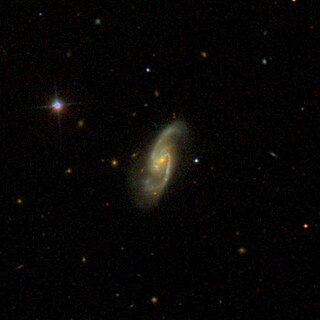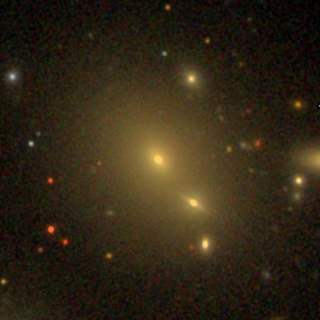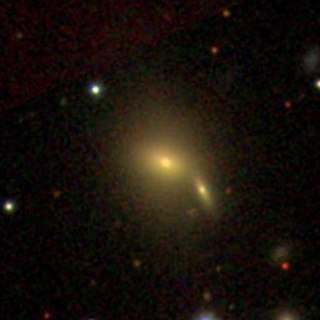The topic of this article may not meet Wikipedia's notability guideline for astronomical objects .(January 2021) |

NGC 6002 is a star located in the constellation Corona Borealis. It was discovered on 20 April 1873. [1]
The topic of this article may not meet Wikipedia's notability guideline for astronomical objects .(January 2021) |

NGC 6002 is a star located in the constellation Corona Borealis. It was discovered on 20 April 1873. [1]

This is a list of lists, grouped by type of astronomical object.

NGC 5921 is a barred spiral galaxy located approximately 65 million light-years from the Solar System in the constellation Serpens Caput. It was discovered by William Herschel on 1 May 1786. In February 2001 a type II supernova was discovered in NGC 5921. It is a member of the Virgo III Groups, a series of galaxies and galaxy clusters strung out to the east of the Virgo Supercluster of galaxies.

NGC 5890 is an unbarred lenticular galaxy in the constellation Libra. It was discovered in April 1785 by Ormond Stone.

NGC 5256 is an object that contains two disc galaxies, that are colliding into each other. It is located in the constellation Ursa Major, and was discovered by William Herschel on 12 May 1787. The two nuclei of the galaxies are separated by about 13,000 light-years. The southwest and northeast nuclei have masses of 7×109 M☉ and 10×109 M☉, assuming they orbit around a common center of mass. NGC 5256 is located at about 420 million light-years away from the Earth.

NGC 5001 is a barred spiral galaxy located in the constellation Ursa Major. It is designated as SB in the galaxy morphological classification scheme. It was discovered by John Herschel on 1 May 1831. It is at a distance of 130 million parsecs from the Earth.

NGC 6000 is a barred spiral galaxy located in the constellation Scorpius. It is designated as SB(s)bc in the galaxy morphological classification scheme and was discovered by John Herschel on 8 May 1834. The galaxy is approximately 103 million light-years away. It is the brightest of all the galaxies in the constellation Scorpius.
Two supernovae have been observed in this galaxy, namely 2007ch and 2010as, each having a magnitude of about 17.2 and 15.5 respectively.

NGC 5640 is a spiral galaxy approximately 660 million light-years away from Earth in the constellation of Camelopardalis. It was discovered by British astronomer William Herschel on December 20, 1797.

NGC 5774 is an intermediate spiral galaxy approximately 71 million light-years away from Earth in the constellation of Virgo. It was discovered by Irish engineer Bindon Stoney on April 26, 1851.

NGC 5609 is a spiral galaxy located 1.3 billion light-years light-years away from Earth, in the constellation Boötes. It has the largest redshift of any galaxy in the New General Catalogue. Prior to 2023, another spiral galaxy, NGC 1262, had been thought to have a higher redshift. NGC 5609 is the most distant visually observed galaxy in the NGC Catalog and was discovered by astronomer Bindon Blood Stoney on March 1, 1851.

NGC 5114 is a lenticular galaxy located about 170 million light-years away in the constellation Centaurus. The galaxy was discovered by astronomer John Herschel on June 3, 1836.

NGC 6028 is a barred lenticular galaxy and a ring galaxy located about 200 million light-years away in the constellation Hercules. Ring galaxies such as NGC 6028 are also known as Hoag-type galaxies as they may have a resemblance to the prototype, Hoag's Object. NGC 6028 was discovered by astronomer William Herschel on March 14, 1784. It was then rediscovered by astronomer Guillaume Bigourdan on May 4, 1886.

NGC 6039 is a massive lenticular galaxy located about 460 million light-years away in the constellation Hercules. NGC 6039 was discovered by astronomer Édouard Stephan on June 27, 1870 and later rediscovered by astronomer Lewis Swift on June 27, 1886. NGC 6039 is member of the Hercules Cluster, which is part of the CfA2 Great Wall.

NGC 6040 is a spiral galaxy located about 550 million light-years away in the constellation Hercules. NGC 6040 was discovered by astronomer Édouard Stephan on June 27, 1870. NGC 6040 is interacting with the lenticular galaxy PGC 56942. As a result of this interaction, NGC 6040's southern spiral arm has been warped in the direction toward PGC 56942. NGC 6040 and PGC 56942 are both members of the Hercules Cluster.

NGC 6041 is a giant elliptical galaxy located about 470 million light-years away in the constellation Hercules. NGC 6041 has an extended envelope that is distorted towards the galaxy pair Arp 122. NGC 6041 is the brightest galaxy (BCG) in the Hercules Cluster. The galaxy was discovered by astronomer Édouard Stephan on June 27, 1870.

NGC 6043 is a lenticular galaxy located about 444 million light-years away in the constellation Hercules. NGC 6043 was discovered by astronomer Lewis Swift on June 27, 1886. The galaxy is a member of the Hercules Cluster.

NGC 6044 is a lenticular galaxy located about 465 million light-years away in the constellation Hercules. NGC 6044 was discovered by astronomer Lewis Swift on June 27, 1886. It was then rediscovered by astronomer Guillaume Bigourdan on June 8, 1888. NGC 6044 is a member of the Hercules Cluster.

NGC 6045 is a barred spiral galaxy located about 450 million light-years away in the constellation Hercules. NGC 6045 was discovered by astronomer Lewis Swift on June 27, 1886 and is a member of the Hercules Cluster. It is also a LINER galaxy.

NGC 5678 is a barred spiral galaxy in the constellation Draco. It was discovered by William Herschel on April 17, 1789.